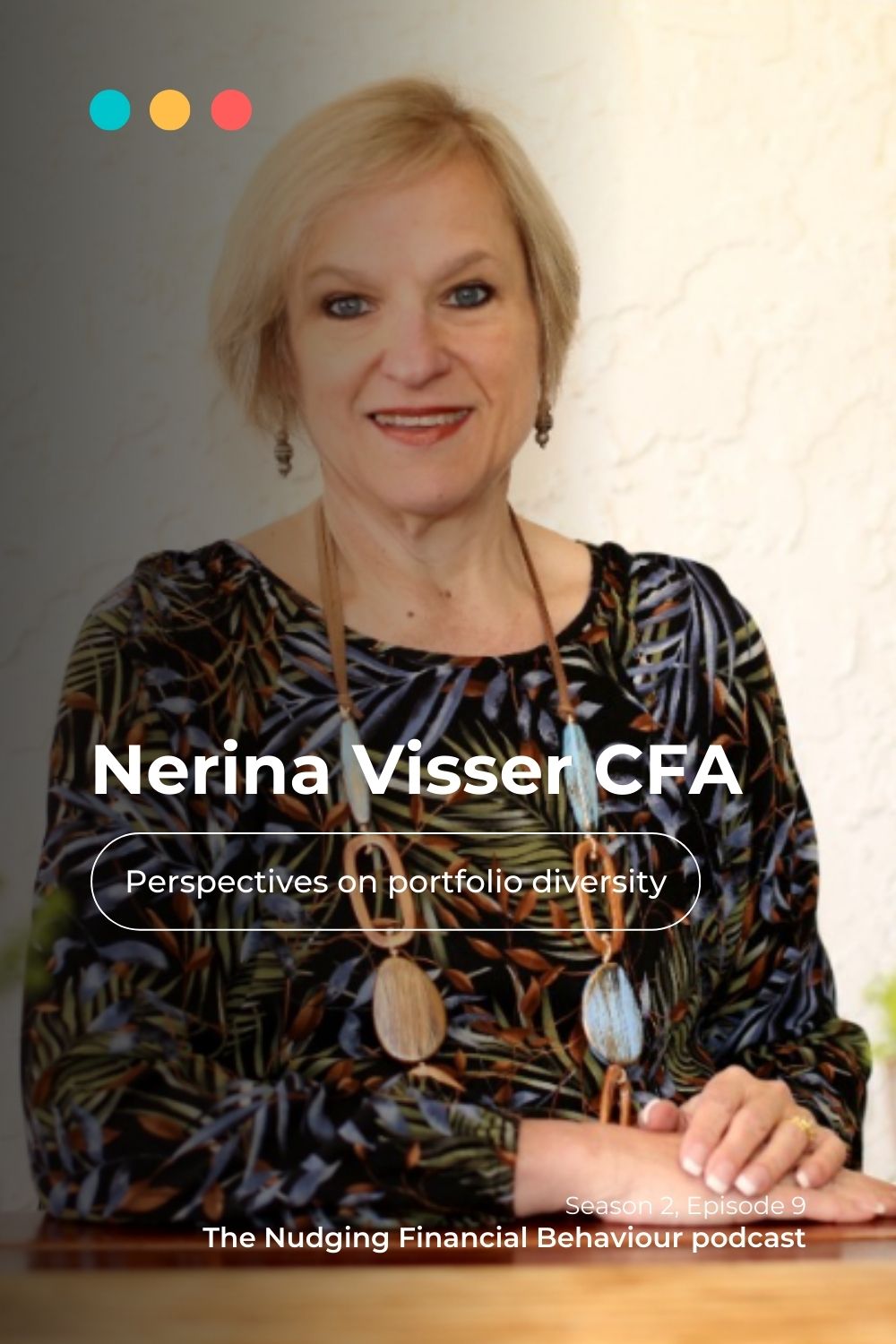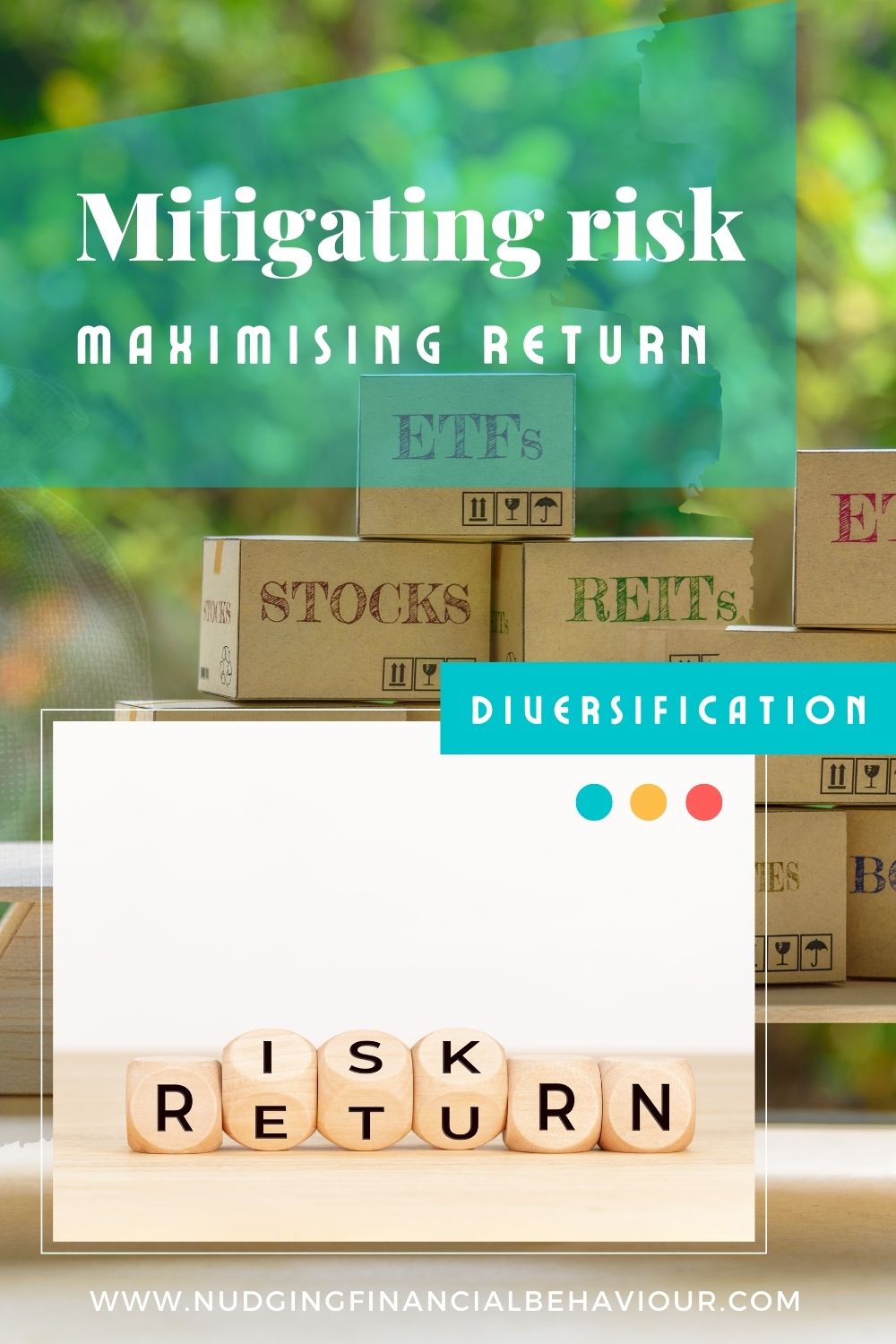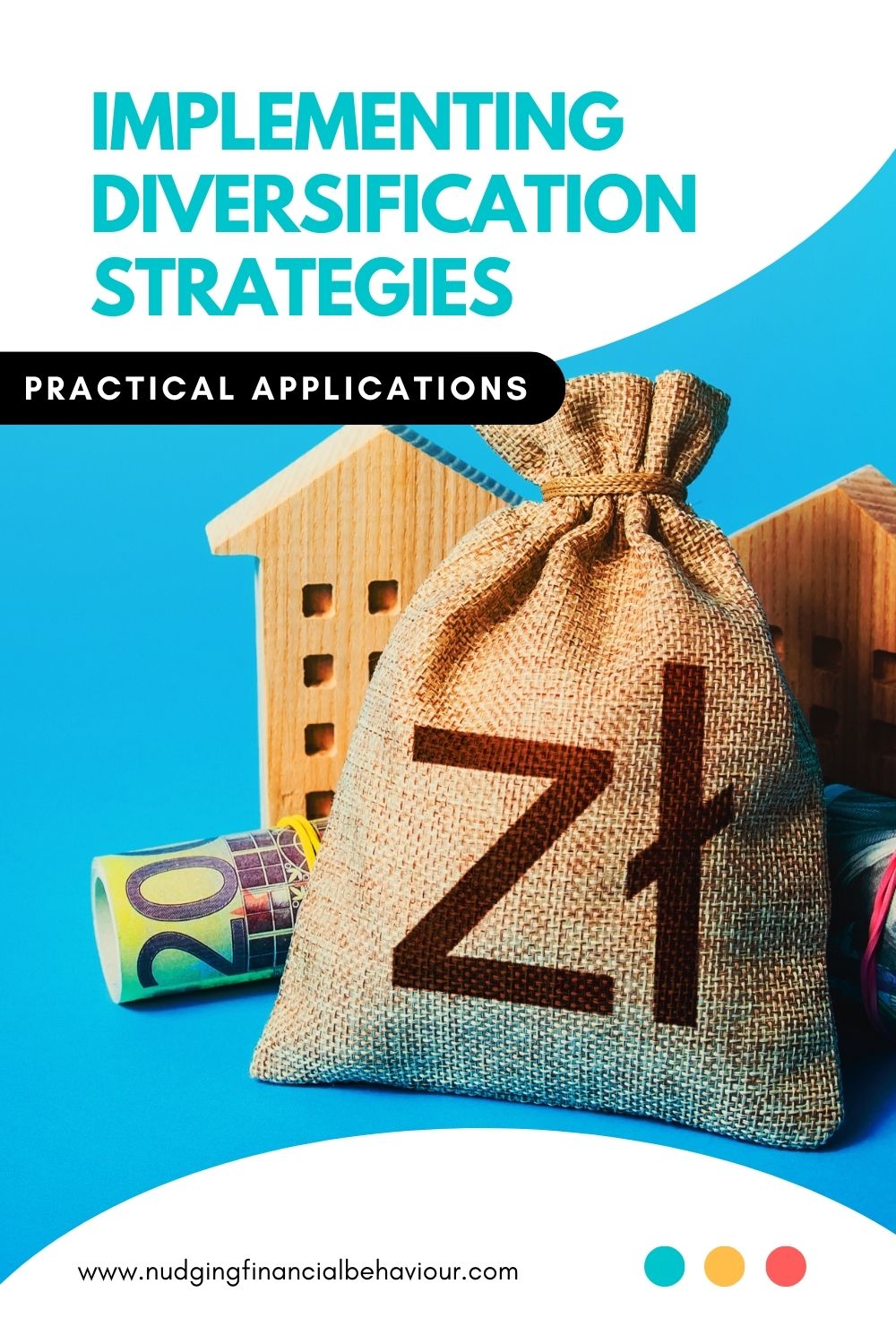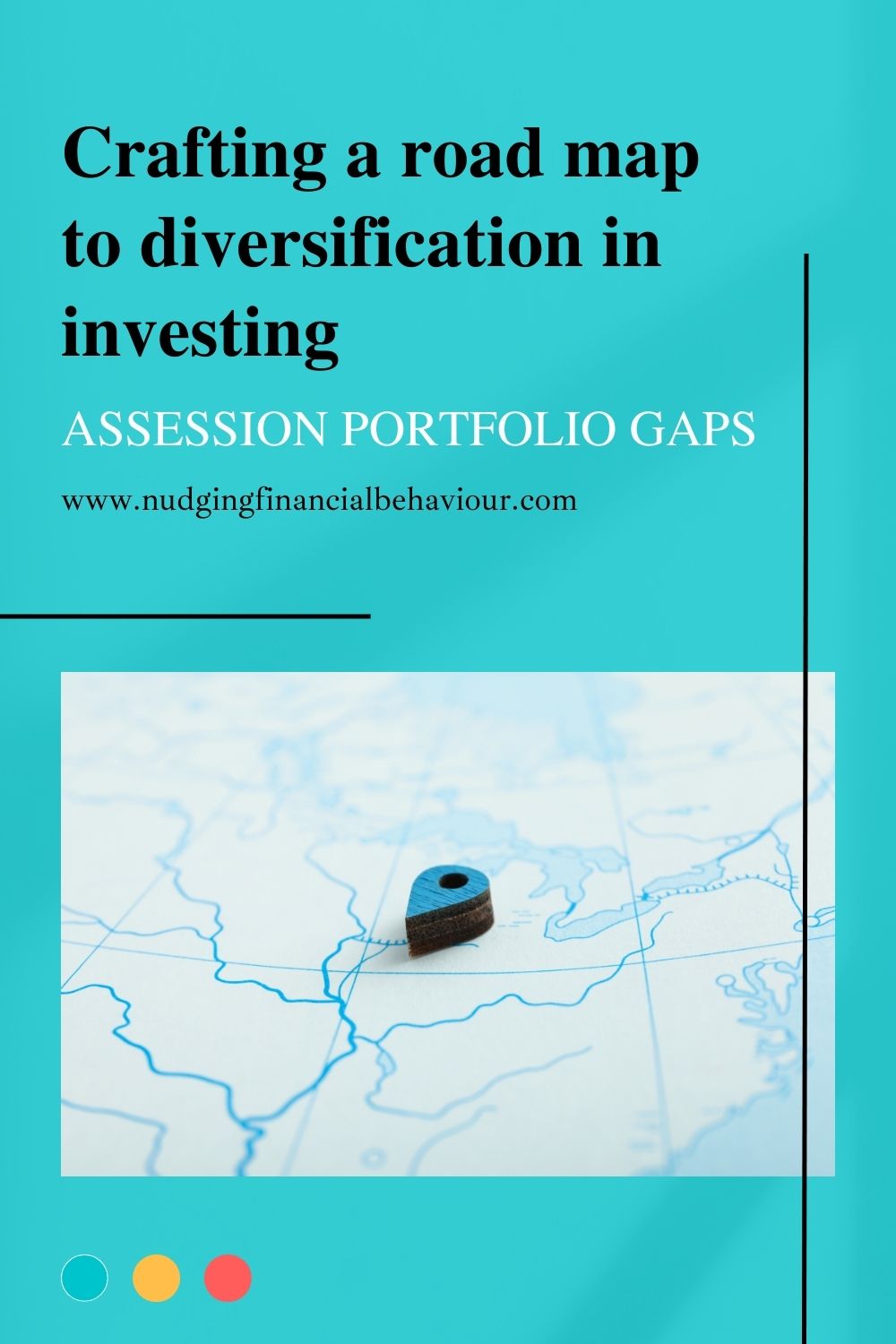Here we are at Episode 9 of Season 2 of the Nudging Financial Behaviour podcast. In this episode, we’re continuing our discussion on home bias, looking specifically at how we can overcome this bias by ensuring we have proper diversification in our investment portfolios. Diversification in investing is essential!
We’re also really excited about our guest, Nerina Visser, from ETF SA, who is going to help us through this process. You’re going to get a lot of practical tips in this post!
Please subscribe to our channel if you haven’t done so already. You’re also more than welcome to listen to a recording of this episode on any of your favourite podcast streaming platforms.
Let’s take a look at what diversification in investing means. It’s actually a risk management strategy for investing (now you know why I spent so much time talking about risk at the beginning of the season – it keeps on coming up in investing).
When you have a diversified investment portfolio, you have investments across a range of different asset classes – from various industries to different countries to a variety of financial instruments. The reason this is considered less risky is because you aren’t putting all your eggs in one basket and hoping that the market doesn’t drop that basket for you. By spreading investments across asset classes, we mitigate the risk of overexposure and aim to secure more stable returns over time.
Diversification, a risk management strategy, forms the bedrock of sound investing. Share on XThere are basically five different types of asset classes: equity, interest-bearing assets, real estate, physical commodities, and cash.
We have equity… investing in the market. This is usually the engine house of your portfolio as it helps it grow. But, we know the market is volatile, so that’s why these types of assets are generally suitable for a longer term horizon.
Then we have interest-bearing assets… things like bonds, preference shares, currency notes… These bring in income for your portfolio.
Next, we have real estate or property. This can be the physical asset… so that property you live in that you also own counts. But it can also be investing in listed property funds. As property generally has low correlation to shares, it can bring nice diversity to your investment portfolio. It can also provide a hedge against inflation.
Then we have physical commodities, for those who like to invest in precious metals. There’s no payoff, no dividends, no interest… but as they have a different pay-off profile, they can be a good hedge.
Finally, we have cash, money market accounts, fixed income type investments, which can give your portfolio some stability. It gives you liquidity and as it’s a lower risk investment, it’s well-suited for a shorter-term horizon.

I have always believed that investing in a diversified array of stocks is the best way to build wealth over time.
Diversification is the only free lunch in investments; use it. Each of these asset classes provide unique characteristics and serve specific investment objectives, providing investors with a spectrum of opportunities for portfolio construction. Don’t put all your eggs in one basket.
Let’s get the advice from someone who knows a lot about diversifying your investment portfolio … Nerina Visser is a CFA, and was president of the CFA Society in South Africa. She’s also passionate about financial education and empowering people. To this end, Nerina regularly offers her services as a market commentator.
We asked her why it is important for us to regularly evaluate our portfolio from a diversity perspective?
I think when we think in terms of a general investment portfolio, it is quite likely that you might have in your investment portfolio, at least some investments where you as the individual investor, were not solely responsible for selecting those investments, especially when we look at things like unit trusts, for example, or ETFs, which are also unit trusts, where the underlying fund might be something that’s put together by a professional fund manager.
And so, you don’t necessarily always know exactly what’s inside each of those. And if we think of a unit trust or an ETF… like a hamper, a basket of goodies, think a little bit like you know those lucky packet hampers that we got when we were children, you know, where it looked very shiny and pretty from the outside, but you actually had no idea what you were going to get inside. Whereas if you have the ability and we certainly have that ability with very transparent products like ETFs, but if you have the ability to actually open up that hamper, open up that basket of goodies and see what’s actually inside, we will know much better.
But because these things change over time, we need to regularly revisit that. Go back and say does this thing still actually hold what I think it holds or does it now maybe hold something which I already have in many other places in my portfolio.
Drawing from her extensive expertise, Nerina emphasises the importance of periodic portfolio evaluation to ensure alignment with investment objectives. Transparency and understanding of underlying assets are critical in maintaining a well-diversified portfolio.

Some of these investments might be fairly consistent in terms of what they hold as the underlying investments, but others could actually change quite substantially over time and that’s why I think it’s a very good and almost like a hygiene, a regular investment portfolio hygiene to go back, revisit, engage – what’s inside my investment and ensure that you’re sufficiently diversified.
For those that don’t even know where to start with assessing your investments this way, it might be useful to consider industry guidelines of how much of your investment portfolio should be sitting in each of the asset classes we discussed early. Nerina gave some guidance on this.
When we think in terms of different asset classes, typically we think of these as different groups of investments that offer different payoff profiles, if I can put it that way. So, we would typically talk about things like growth assets. That’s typically your equities or your shares, where the main intention of that investment is really about the capital growth, the price appreciation that you get over time.
Other types of assets focus a lot more on the income component. So, here the income could either be interest rates that you receive, could be dividends for example, but the main focus of that type of investment is about income generation. And not necessarily income only for you to earn as an income as an investor and to live off that income, but also because income to a large extent provides almost a bit of a stabilizer in portfolios.
When we look at total return, it’s a combination of capital gain or price appreciation, and to the yield or the income that you get from that portfolio. And so different asset classes are going to have different proportions of capital gain contributions to total return and then interest or income yield to the total return.
I think from that perspective… when you say things like industry guidelines around this, this is very much about starting from the perspective of the investor objective, the investment needs that you have. So, is this an investment that is earmarked and really looking at long-term capital growth, in which case you want a much higher proportion to growth assets, i.e. equities, versus if the main objective of that portfolio is one really to either provide an active income or at least have a lower risk profile because of the support that that income gives into the total return.
Industry guidelines offer valuable insights into asset allocation, tailoring investment strategies to individual objectives. Whereas aiming for long-term growth or seeking income stability, understanding asset class proportions is key to crafting a diversified portfolio.
From a broad perspective, when you look at ASISA [Associations for Savings and Investments in South Africa] classifications, and, when we look at multi-asset portfolios, also known as balanced funds by many people also in industry, we typically find that a high equity portfolio would have up to 75% of that portfolio just in equities. When you look at the low equity portfolios, we’re typically looking at something where the equity exposure could be as low as 40%.
Of course, you could have an equity only portfolio where you literally would have 100% in equities. You could have an income only portfolio where 100% would be in interest bearing, either cash or bonds or so.

So, I think from that perspective, the 40 to 75% guideline is typically what you’re going to find within industry. And interestingly enough, also when we look at the likes of Regulation 28 of the Pension Funds Act, which is really the one that says, how does the pension fund industry, how are they allowed to invest assets? We do have a limit there in terms of equity exposure in a retirement portfolio, which is also 75%. So that gives you some sort of indication of broadly, depending on your objectives, how you should be thinking about your allocation to different asset classes.
Always remember that these are guidelines. We all need to consider those percentages and decide what works for us… and if you need any help with this, you should speak to a financial planner and get some input from them as well.
We’re really talking very broadly here, you know, as if all equities are one single homogeneous asset class. But I mean, let’s just start with the geographic decision, for example, are we talking about South African equities or are we talking about global equities? When we talk global, is this about developed markets or is it about emerging markets? Is this US only or are we looking at UK, Europe?
Add to that things like different industries, you know, are we talking mining companies or financial companies or technology companies or going even another step further and say different types of investment styles, is this a group of equities that offer high dividends for example or exhibit strong momentum or represent good value, you know, these are all different ways in which we can look at this broad asset class called equities.
Diversification is the strategy of investing in a variety of asset classes and among many securities in an attempt to lower overall investment risk.
And yes, certainly I think professional assistance or doesn’t have to be a professional, you can certainly educate yourself but understand that if you’re going to do this yourself, you probably need to have the time, the capacity and the appetite to engage with this sufficiently in order to make a well-informed decision.
As the Queen of ETFs… we needed to ask Nerina what some of her favourite ETFs are for these particular asset classes.
I always prefer to start with really the broadest type of exposure that would capture the big broad asset class for me. So, if I’m gonna look at equities, for me the starting point would be global equities. And remember, South Africa is part of that global.
So, we have a wonderful ETF listed on the JSE by 10X. It’s called the Total World ETFs. And it is exactly what it says it is. The underlying investment, the underlying index gives you investment exposure to approximately 9 000 companies globally. It covers developed markets and emerging markets. It covers large cap, mid cap and small cap shares. So really a single investment that can give you as the investor a one-stop shop really to get exposure to most of the prominent and important companies in the world.
Similarly, we can do something just within the South African market because maybe your focus in your portfolio is specifically just on South African investments. And in this context, we have the Satrix capped all share ETF. That one is again, as the name says, all share. So, it invests in all of the shares that are listed on the JSE. It is capped. So, what that does is it actually just limits the exposure that you would have to any one company to 10 percent. And for me, again, that is a really good single investment that’s going to capture the entire South African equity market for me.
And similarly, we can then start looking towards other asset classes as well. Most of our bond or interest bearing investments that we have available via ETFs are focused on government bonds. It is by far the biggest component of our market. And we often get people sort of asking about contrasting something like retail savings bonds with a government bond ETF. A bond ETF is a great way for a retail investor to get exposure to government bonds, which normally would require a minimum investment of a million Rand to buy just one bond.
And similarly, we can then start looking towards other asset classes as well. Most of our bond or interest bearing investments that we have available via ETFs are focused on government bonds. It is by far the biggest component of our market. And we often get people sort of asking about contrasting something like retail savings bonds with a government bond ETF. A bond ETF is a great way for a retail investor to get exposure to government bonds, which normally would require a minimum investment of a million Rand to buy just one bond.

Nerina offers invaluable guidance by translating diversification principles into actionable strategies. She emphasises the importance of selection ETFs strategically, considering the role in achieving a well-diversified portfolio. By leveraging ETFs, investors gain exposure to a wide range of assets, spanning equities, bonds, commodities, and real estate, without the need for intricate stock-picking or extensive research.
I really think that if an investor starts with a very simple portfolio of a good chunk of global equities, a reasonable proportion of South African equities, because this is still our home market, so this is where we live and work and we’ll probably need income, and then supported with that, some good interest bearing government bonds…
Amidst the pursuit of diversification, Nerina issues a cautionary note against what she terms “diworsification”. This phenomenon occurs when investors overly complicate their portfolios with an excessive number of holdings, diluting the potential benefits of diversification in investing. Instead, she advocates for a balanced approach that prioritises strategic allocation over unnecessary complexity.
I think often people think that they are diversified if they hold multiple investments, so multiple different ETFs in a portfolio. And I use the term DIWORSIFICATION where you think you are diversified, but actually you’re not.
So, let’s just quickly think in terms of sort of the construct of the investment world as it stands at the moment. By and large, the developed markets are about 85% of the global investment opportunity set and 15% in emerging markets. The next thing to look at is within developed markets, the US is pretty much two thirds of the developed market. Similarly in China, we’ve also seen China, a massive representation of emerging markets.

So, what we often find is that we see people invest in something… I think one of the favourite ones for many people is an MSCI world ETF because the name sounds like it’s the world, the whole world, but actually that’s just developed markets. So, by investing in the MSCI world, you’re excluding all emerging markets and… What you don’t maybe realise is that two thirds of that investment is already the US. So, then I see people couple that MSCI World with the likes of an S&P 500. And they think, oh, now I’m diversified. But actually, there’s a significant overlap between those two.
Add on to that… And this often comes from people’s sort of choice of investments on the basis of past performance. I mean, we’ve certainly come through a decade or more of exceptionally strong performance from US equity markets. So, they look at something like the S&P 500 and how well that’s performed, and they look at the NASDAQ and how well that’s performed, and they think, oh, let me put in these two US equity exposures. Meanwhile, the overlap between those two are also significant. I think a term that was coined during 2023 was the Magnificent Seven, the seven largest companies that really dominate US equity markets and is now a significant proportion of the S&P 500 and a significant portion of the NASDAQ 100.
By thoughtfully selecting a handful of high-quality ETFs that span different asset classes and geographical regions, investors can harness the power of diversification in investing while avoiding the pitfalls of diworsification.
These are some of the unintended consequences that I often see that people end up with in their portfolios. I mean, I’m not even going to go to the point where people think that they can buy the same S&P 500 ETF, but from multiple ETF providers and then think that they are diversified. No. As we often say, you might be diversified amongst street addresses in Cape Town, but that’s about the extent of the diversification that you have in your portfolio.
Nerina’s insights underscore the importance of simplicity and clarity in portfolio construction, reminding investors that the ultimate goal of diversification in investing is not complexity for its own sake, but rather the mitigation of risk and the enhancement of long-term returns. There’s no guarantee against loss, but you limit your exposure.
Now, not only is Nerina the Queen of ETFs, she’s also the Queen of Excel. So, yes, of course there is an excel template that she’s developed that you can use to do all we’ve discussed in this episode… set your diversification goals… look at how diworsified you are currently … and plan how you’re going to get from where you are now to where you want to be.
But next, let’s discuss what we should do if we look at our portfolio and see that we aren’t perhaps as diversified as we’d like to be. What should our action plan be?
For me, a very important starting point is first to design almost my ideal. Where would I like to be? What do I want my portfolio to look like given my investment objectives, given my needs, might be income or whatever the case might be. So have a, almost a target diversified portfolio view in mind. Then to go and look at what do I currently have?
And that’s where that spreadsheet, I think, becomes quite helpful in terms of just doing an aggregation also of the different types of investments that you might have because you might have a pension or provident fund at work or an RA or you might have a tax-free investment account, or you might have more than one discretionary investment account. So, to aggregate all of those together to get a proper view of what is my current state of play.
And then I go to the step of thinking of the London Underground and the Mind The Gap. Now I’ve got to mind this gap between where I am and where I want to be. And the plan then comes in to say, how do I progress from where I am to where I want to be in the most cost efficient and tax efficient way? So those are very important considerations because it’s not just about throwing everything out that I’ve got now, selling out of everything, incurring a lot of costs and possible capital gains tax and all of that just to get to my target. No, it is a process and it’s a process of moving from where you are to where you want to be.
Something to highlight is that you might have different investment pots, be that retirement savings or tax-free savings, and then discretionary savings. As an ordinary pension, provident or retirement fund member, you don’t have the option of choosing the individual underlying investment. But it’s good to understand what it is that you’re getting there. Therefore, any gaps that you identify elsewhere, you can make adjustments in your discretionary investments, or even your tax-free investments. That’s the portfolio that makes up for everything else and provides you with a completion strategy. Next, you can consider where your ongoing contributions go.
We are very strong sort of promoters of regular investment contributions… that’s a great way to build wealth over time. Look at what you are contributing on a regular basis through a monthly debit order, for example, and then allocate to that monthly contribution that you’re making to the asset class or to the component where you’ve got the biggest gap, where you’ve got the biggest shortfall.
Designing an ideal portfolio, assessing current holdings, and bridging gaps form the foundation of a strategic diversification plan. Regular contributions, aligned with identified shortfalls, pave the way for portfolio optimisation and long-term wealth accumulation.

You’ll hear that this thinking around how I allocate my new contributions, my new investments, has got very little to do with what is the state of the markets? Are we high? Are we low? Did the markets just fall? You know… should I be getting out the country because the Rand is going to hell in a hand basket or whatever? None of those considerations feature in my plan that says I am addressing my own gaps, my own shortcomings in my portfolio and I’m using this as the opportunity to move myself closer to my target which I’ve identified as the most appropriate portfolio allocation for my specific investment needs and objectives.
Did we promise some practical tips in this post, and you’ve certainly got them. I do need to stress though that this is all general advice. For specific advice on your portfolio – please go and talk to a financial advisor.
Informed decision-making and continuous learning are cornerstones of financial empowerment. Nerina encourages investors to engage actively with their finances, emphasising the significance of personalised strategies over generic advice.
You know, I really believe that an informed investor is probably the best investor that they could be. And I really enjoy when people are prepared to engage with their investments, engage with their money. Remember, none of us are born financial geniuses. We don’t know this stuff when we’re born. And in fact, we don’t learn this at school. We all have to learn this as we go along. So, I also just want to encourage your listeners to continue engaging with what you offer, with the financial education that’s out there, educate yourself, learn about this, and then apply it to you personally, because that is the most appropriate plan. The most appropriate plan is not what your friend or your mother or your boss is doing. The most appropriate plan is something that works for you.
Set diversification goals for yourself. Consider the industry guidelines that are available for anyone to use. Next, take some of Nerina’s advice and assess for yourself – look at your current circumstances, where you want your money to be, and what you want to be exposed to.
Then, go grab the fact sheets or similar for each of your investments, the market value of any property… and do some maths. A pie chart is a great way to visualise this.

Diversification is about catching the right waves at the right time.
Finally, compare where you are now to where you want to be. Make some notes for yourself… focus on the low hanging fruit… for now, it might just be that you have too much sitting in cash. That’s an easy fix.
Or maybe it’s that you don’t have enough in emerging markets… well, now you know where to put that extra cash…
Incorporating Nerina’s recommendations into one’s investment strategy empowers investors to navigate the complexities of the financial markets with confidence, building resilient portfolios poised for sustainable growth and wealth preservation.
Diversification is your buddy.
As we conclude our exploration of home bias and diversification, you know what’s coming in the final episode of season 2, right? We’re going to hear from all our guests again… as they share some bad financial decisions they’ve made (we’re all human), and they’ll also help us recap everything we’ve learnt in this season!
Narrow framing – Narrow framing, the compromise effect, glossing, and the enabling frame. We need frames to make sense of the world. But they cause problems.
The anchored trader – Anchors tie us down and can have serious consequences for investors and traders. Don’t be the anchored trader.
Share your answers in the comments below.
[apsp-follow-button name=’nudgingfinancialbehaviour’ button_label=’Follow on Pinterest’]
I am passionate about helping people understand their behaviour with money and gently nudging them to spend less and save more. I have several academic journal publications on investor behaviour, financial literacy and personal finance, and perfectly understand the biases that influence how we manage our money. This blog is where I break down those ideas and share my thinking. I’ll try to cover relevant topics that my readers bring to my attention. Please read, share, and comment. That’s how we spread knowledge and help both ourselves and others to become in control of our financial situations.

Dr Gizelle Willows
PhD and NRF-rating in Behavioural Finance
Receive gentle nudges from us:
[user_registration_form id=”8641″]
“Essentially, all models are wrong, but some are useful.” – George E.P. Box
